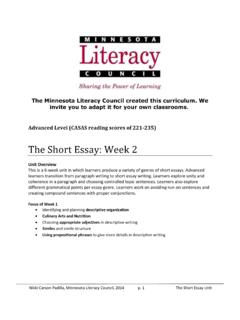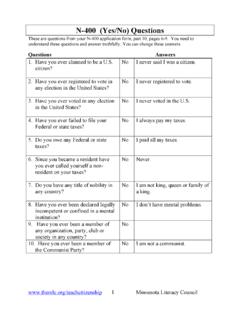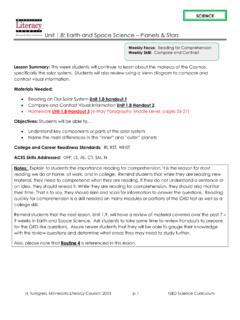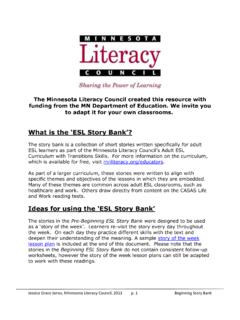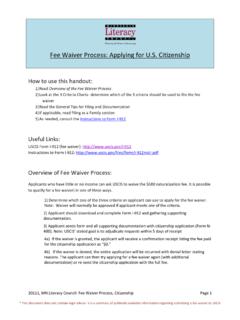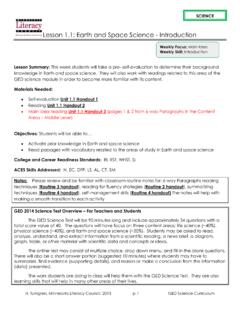Transcription of Money: Week 1 of 2 - Minnesota Literacy Council
1 Jessica Grace Jones, Minnesota Literacy Council , 2012 p. 1 Beginning money Unit The Minnesota Literacy Council created this curriculum with funding from the MN Department of Education. We invite you to adapt it for your own classrooms. Beginning Level (CASAS reading scores of 181-200) money : week 1 of 2 Unit Overview This is a 2- week unit in which students will become more comfortable quickly recognizing and counting American money . They will also practice reading sale and discount information and learn the names of several common house wares. Focus of week 1 Coin and bill identification House wares vocabulary Asking questions about singular and plural nouns Checks and money orders Jessica Grace Jones, Minnesota Literacy Council , 2012 p. 2 Beginning money Unit money Unit: week 1, Monday Objectives Learners will be able Materials Life skill: read and write dollar amounts to the hundreds place Literacy : recognize and write ten common house wares; match dollar amounts with pictures of currency Listening/speaking: pronounce dollar amounts intelligibly; verbally identify coins and bills (penny, nickel, etc.)
2 Transitions: practice counting money and paying for items Grammar: Recognize and sort singular and plural nouns Make Student Copies Textbook: Grammar in Action, p. 90-91 Handout: Practice Reading Test Handout: American money Props, Technology or Other Resources real coins and play money Lesson Plan Warm up for today s Lesson: Description: 10-minute free write and partner share: What was the first thing you remember buying in the Materials/Prep: (none) Activity 1: Life skill, listening and speaking Description: learners will read coins to practice identifying the name and value of coins Materials/Prep: 2-3 real coins of each denomination, copies of American money handout, play money Activity 2: Life skills, Literacy Description: learners will complete a practice reading test Materials/Prep: copies of Practice Reading Test handout Activity 3: Grammar/ Literacy Description: introduce kitchen housewares vocabulary and sort into singular and plural Materials/Prep: copies of Basic Grammar in Action, p.
3 90-91 Activity 4: Transitions: Navigating and Understanding One's Environment Description: learners will use play money to practice counting out exact change Materials/Prep: play money Jessica Grace Jones, Minnesota Literacy Council , 2012 p. 3 Beginning money Unit Teacher Directions: Activity 1: Life Skill/Listening & Speaking American money Step 1: Activate prior knowledge Show examples of real coins and bills (not play money ). Ask How money is this? (allow learners to answer the question but don t worry if they have incomplete information at this point) Step 2: Introduce vocabulary Use the American money handout to introduce and practice the names and amounts of the currency. Learners repeat the pronunciation of the words several times before and after writing the amounts. Step 3: Controlled Practice Give each learner (or pair of learners) one of each coin (real, if possible).
4 Say Show me a penny. Or Show me five cents. Learners hold up the appropriate coin. When they have mastered the individual coins, call out amounts that require two or more coins. Step 4: Independent Practice Write on the board: Do you have five cents? Sure, here you go. Learners work in pairs to continue the practice from step 3 using this simple dialog and asking for different amounts or coin names each time. Need a challenge?: give each group a larger amount and variety of bills and coins so that they can practice with larger and more complicated amounts. Jessica Grace Jones, Minnesota Literacy Council , 2012 p. 4 Beginning money Unit Teacher Directions: Activity 2: Life Skills/ Literacy Practice Reading Test Step 1: Independent Practice Before distributing the questions, remind learners that this is practice for their reading test. During the test they should not talk, look at their notebook or dictionary, or look at other learners papers.
5 Model how to read the questions first, then the information above, then go back and circle the correct answer. Give everyone 3 minutes to complete questions 1-2. Use this time to walk around the room and see who has easily mastered this skill and who might need extra practice. Step 2: Reviewing Answers Use a projector to show the questions. Invite a student to come up and circle the correct answer. They should also circle the information above the questions that helped them find the correct answer. If there is much dispute about the correct answer, discuss all the answers as a class and model how to eliminate wrong answers. Teacher Directions: Activity 3: Grammar/ Literacy -Basic Grammar in Action, p. 90-91 Step 1: Review Review the pronunciation of the coins and bills. Step 2: Introduce Vocabulary Teacher says each of the kitchen items as learners point and repeat. (at least 2 times) Because the line drawings can be confusing, check for comprehension with simple questions like What do you cook in toaster oven?
6 Why do you use pot holders? What do you eat with a fork? Write on the board: I have _____ in my kitchen. Model by saying several example sentences using the words on p. 91 in the sentence above. Jessica Grace Jones, Minnesota Literacy Council , 2012 p. 5 Beginning money Unit Call on learners to talk about their kitchens (don t worry about singular and plural grammar at this point). Step 3: Introduce grammar concept: Singular and Plural Learners circle the pictures on p. 91 that show more than 1 item. Underline the letter S at the end of each of those words: mugs, knives, dishes Show that the words dishes and glasses have es endings. s and es endings are for 2 or more things. Write on the board: 1 thing singular, 2 or more things plural Return to the sentence I have _____ in my kitchen. Model in writing how to write a before each singular item and s or es at the end of each plural item.
7 Step 4: Independent practice Learners write 5 sentences in their notebook about things they have in their kitchen. As they write watch for singular and plural errors. Teacher Directions: Activity 4: Transitions & Critical Thinking Step 1: Context Write on the board: When I take the bus, I put exact change in the machine. Discuss the sentence: Who takes the bus? Do you use cash or a card? Where do you put the money ? How much money ? Does the driver give change? Write on the board: exact change -the correct amount of money . Not more or less. Learners copy in their notebooks. Step 2: Teacher Guided Practice Give each learner a few bills and a handful of coins (play money ) Make sure they can identify the amounts of each of the coins. Write an amount less than $1 on the board. Each learner counts out that amount of money and shows it to the teacher. Alternate writing and saying the amounts.
8 Gradually give them more difficult amounts but only after they have mastered easier amounts. Jessica Grace Jones, Minnesota Literacy Council , 2012 p. 6 Beginning money Unit American money Copy the numbers and words. $ one dollar _____ _____ _____ _____ $ five dollars _____ _____ _____ _____ $ ten dollars _____ _____ _____ _____ $ twenty dollars _____ _____ _____ _____ Jessica Grace Jones, Minnesota Literacy Council , 2012 p. 7 Beginning money Unit American money Copy the numbers and words. $ one cent _____ _____ _____ _____ $ five cents _____ _____ _____ _____ $ ten cents _____ _____ _____ _____ $ twenty five cents _____ _____ _____ _____ Jessica Grace Jones, Minnesota Literacy Council , 2012 p. 8 Beginning money Unit Reading Test Practice 1.
9 How much money is this? A. One dollar B. Five dollars C. Twelve dollars D. Twenty dollars 2. How much is of this? A. 5 dollars B. 10 dollars C. 20 dollars D. 40 dollars Jessica Grace Jones, Minnesota Literacy Council , 2012 p. 9 Beginning money Unit money Unit: week 1, Tuesday Objectives Learners will be able Materials Life skill: read and write dollar amounts Literacy : recognize and write ten common housewares, read and write dollar amounts in words to hundreds place Listening/speaking: verbally identify coins and bills, pronounce dollar amounts intelligibly Transitions: practice counting money , paying, and giving change Grammar: Use singular and plural pronouns to construct sentences about prices (ex. It s $ , They re $ ) Construct how much questions with the correct subject-verb agreement to ask questions about price (ex. how much is the ____? How much are the ___?)
10 Make Student Copies Textbook: Basic Grammar in Action, , 92-93 Handout: How Much? Handout: Writing Numbers Make Single Copies or Reference Manual: Listening Comprehension Drill, p. 54 Manual: Charades/Pictionary, p. 147 Props, Technology, or Other Resources calculators (optional) play money Lesson Plan Warm up for today s Lesson Description: Listening Comprehension Drill to identify American coins and bills Show me a penny. Materials/Prep: ESL Volunteer Tutor Manual, 2012, Listening Comprehension Drill, p. 54. Review of Previous Lessons Description: play Pictionary using kitchen house wares vocabulary from yesterday Materials/Prep: copies of Basic Grammar in Action, for learners absent yesterday, ESL Volunteer Tutor Manual, 2012, Charades/Pictionary, p. 147. Activity 1: Life skill, Literacy , Listening & Speaking Description: learners will practice saying, writing, and listening for dollar amounts Materials/Prep: copies of Basic Grammar in Action, p.
